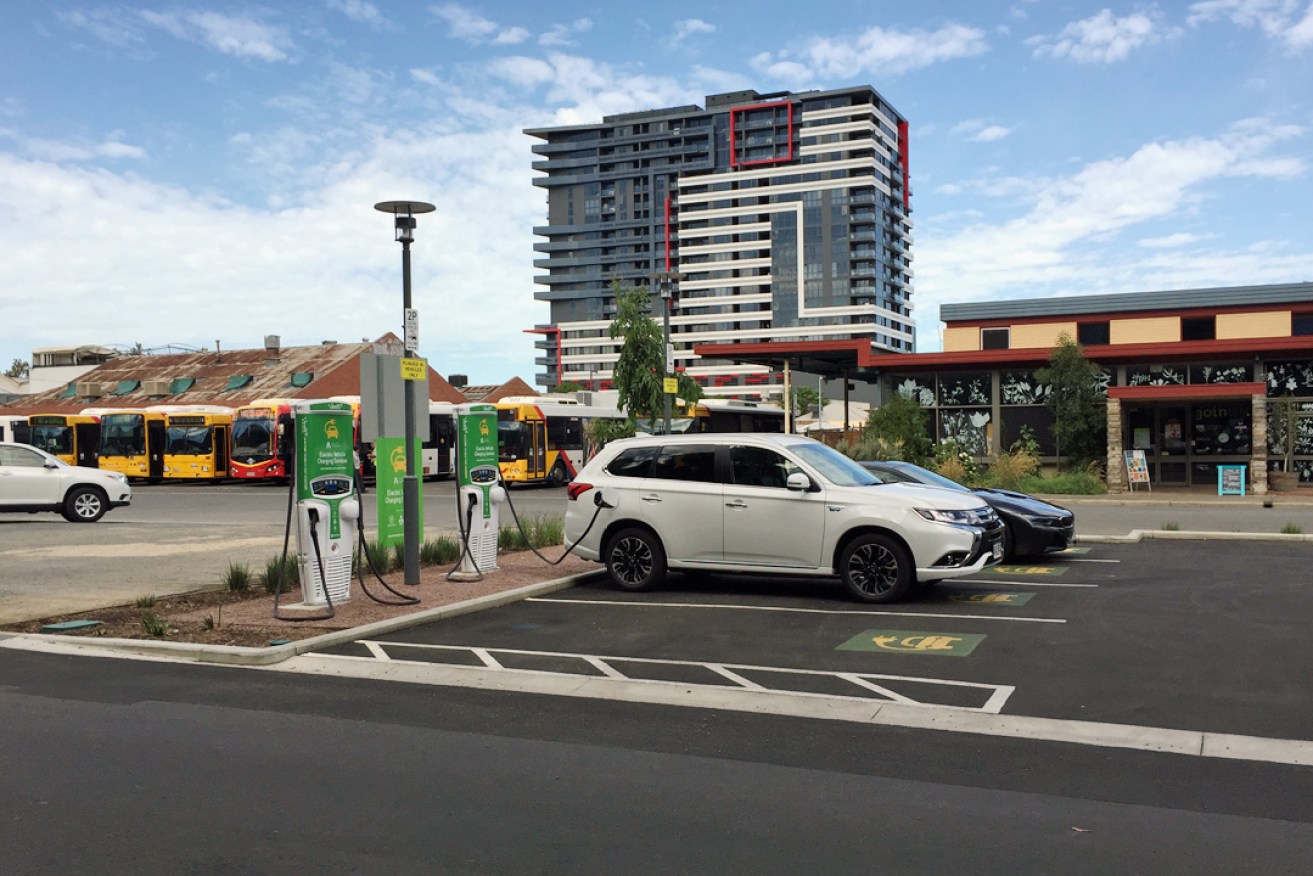Removing road blocks to decarbonising SA’s transport fleets
The transport sector is South Australia’s highest emitter of greenhouse gases, meaning it’s imperative to remove barriers to decarbonising fleet transport, writes Sam Dighton.

Electric vehicles at a charging station in the CBD. Photo: Bension Siebert / InDaily
Finding a fit-for-purpose vehicle might seem like the main consideration when transitioning a commercial fleet to low-emission vehicles. But the reality is, for fleet managers, there are a host of other factors to think about, including whether to invest in onsite charging infrastructure, how to manage cultural change, financing solutions and battery recycling.
In 2023, Australian new car sales hit a record 1.2 million. Fleet vehicles accounted for approximately 46 per cent of all sales, with the figure set to rise above 50 per cent in 2024 as companies and government agencies look to replace ageing stock.
With transport the highest emitting sector in South Australia, contributing 29 per cent of SA’s total greenhouse gas emissions, looking at ways to accelerate the decarbonisation of fleet vehicles is a critical and effective step-change on the road to net zero.
According to new statistics released by the Federal Chamber of Automotive Industries, battery electric vehicle (BEV or EV) sales in Australia hit 87,000 in 2023, almost triple the number of EV sales in 2022 and accounting for 7.2 per cent of the total market share.
While it’s a move in the right direction, current uptake of electric vehicles is largely in the private passenger vehicle space, underscoring the need for accelerated action and offering a golden – or shall we say, ‘green’ – opportunity for businesses to drastically lower emissions in their commercial fleets.
EVs produce zero tailpipe emissions and have roughly half the carbon footprint of a vehicle with an internal combustion engine, according to recent analysis done by the International Energy Agency.
With about 60 models now available in Australia, starting from $40,000, what’s the hold-up and why aren’t government agencies and large companies buying more EVs?
Perceived range anxiety, availability of suitable vehicles, charging infrastructure, budget constraints, and concerns surrounding fire risks associated with lithium-ion batteries are all issues that loom large for fleet managers, often delaying progress.
At a recent SA ZERO event, held in partnership with RAA, local organisations shared their innovative solutions to address these challenges head-on.
Drawing from the collective wisdom of SA ZERO’s partners, several insights emerged for businesses committed to decarbonisation. Chief among them is the imperative to garner internal champions, engage widely and pilot quickly.
It was also clear that EVs themselves are not the barrier, but in many instances, it’s the associated infrastructure, policy settings and the internal culture change required to cater for the transition.
Many organisations run into issues with implementing EV charger infrastructure, requiring engagement and negotiation with landlords, property owners and in some cases, energy network providers.
There’s also the need to rewrite driver policies to account for charging. If a company car is parked at home at night and requires charging, how is the cost to the employee captured? And on the flip side, as vehicle-to-grid and vehicle-to-home charging technology emerges, if an employee plugs a fully charged company EV into their home, can they power their home using company property?
The commitment of the State Government to transition its fleet to electric vehicles represents a significant step forward and will likely set the ‘rule book’ for electric fleet policies.
Concurrently, trials of commercial EVs and creative leasing arrangements within the not-for-profit and private sector also offer promising avenues to alleviate financial burdens and mitigate risk perception.
Earlier this year, RAA announced its first electric patrol van, a Peugeot E-partner van. With a 500kg payload, the patrol van is returning a 50-60 per cent saving on fuel and is delivering a complete roadside service experience to members. Even more pleasingly, the trial is helping to drive a cultural shift among RAA staff, spawning EV advocates as RAA’s future change champions.
The electric patrol van is just one of a number of RAA initiatives underway, including an emergency mobile EV charging service, and the roll-out the state’s first border-to-border EV charging network, comprising 140 charging sites and more than 500 charging bays across South Australia.
There are also other means to decarbonise transport aside from just going electric. The state government is trialling hybrid trains and hydrogen buses, joining a full-battery electric bus, as the latest technology to be trialled across the public transport network.
With the state setting firm targets to reduce greenhouse gas emissions by more than 50 per cent by 2030 from 2005 levels, on the road to achieving Net Zero emissions by 2050, it’s clear we all need to get on board and work together to drive meaningful change in the transportation sector.
The SA ZERO initiative, led by the Committee for Adelaide, is a collaboration aimed at accelerating South Australia’s journey to net zero by 2050. SA ZERO partners include RAA, Flinders Port Holdings, BHP, University of Adelaide, CSIRO, Commonwealth Bank of Australia and the Government of South Australia.
Sam Dighton is the CEO of the Committee for Adelaide




